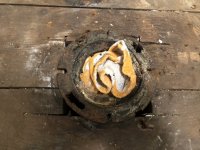Hightechburrito
Member
I'm in the middle of renovating a bathroom of my 1960's built house, and noticed my toilet flange isn't really attached to the flooring. The only thing possibly providing any support were some nails that were driven at an angle into the subfloor and bent over the outside of the flange (can't imagine that helped with the seal). One of these were rusted away completely, and the other 3 weren't really providing any support.
Water damage in this area seems to be the result on an old tub overflow, not the toilet leaking. The nails holding down the underlayment (3/8" particle board for linoleum) had plenty of bite (a bunch actually broke off at the head when trying to remove), and a moisture meter reads about the same value in areas that have never been wet, so I think the subflooring is okay. My plan in to add 1/2" plywood to beef it up and tie everything together, but I had a few question about my flange:
1) I doubt the nails bent over the outside really did anything, so my flange is basically unsupported by the flooring. I can put quite a bit of weight on it and I only moves a few millimeters. I bought the house 7 years ago and it's been fine at least that long (bathroom isn't original but don't know when it was last redone). Am I okay to use this flange as-is? After installation, the toilet will be held up by the floor, and held down by the unsupported flange.
2) If the seal on the new toilet were to fail, it seems that water will just run down the outside of the piping and into the crawlspace below. Is there usually anything done to make the water seep out on top of the finished flooring? I'm planning on having vinyl floating flooring over the plywood, so I could conceivably put silicone between the flange and the flooring, but there's no way to get the area around the closet bolts sealed.
3) Once I place the toilet, should I caulk around the base of the bowl, or just the front? I see people say to leave a gap at the back so you'll see water seeping out if the seal fails, but I'm not certain that I'd see any seeping out the sides anyway.
Thanks.
Water damage in this area seems to be the result on an old tub overflow, not the toilet leaking. The nails holding down the underlayment (3/8" particle board for linoleum) had plenty of bite (a bunch actually broke off at the head when trying to remove), and a moisture meter reads about the same value in areas that have never been wet, so I think the subflooring is okay. My plan in to add 1/2" plywood to beef it up and tie everything together, but I had a few question about my flange:
1) I doubt the nails bent over the outside really did anything, so my flange is basically unsupported by the flooring. I can put quite a bit of weight on it and I only moves a few millimeters. I bought the house 7 years ago and it's been fine at least that long (bathroom isn't original but don't know when it was last redone). Am I okay to use this flange as-is? After installation, the toilet will be held up by the floor, and held down by the unsupported flange.
2) If the seal on the new toilet were to fail, it seems that water will just run down the outside of the piping and into the crawlspace below. Is there usually anything done to make the water seep out on top of the finished flooring? I'm planning on having vinyl floating flooring over the plywood, so I could conceivably put silicone between the flange and the flooring, but there's no way to get the area around the closet bolts sealed.
3) Once I place the toilet, should I caulk around the base of the bowl, or just the front? I see people say to leave a gap at the back so you'll see water seeping out if the seal fails, but I'm not certain that I'd see any seeping out the sides anyway.
Thanks.

